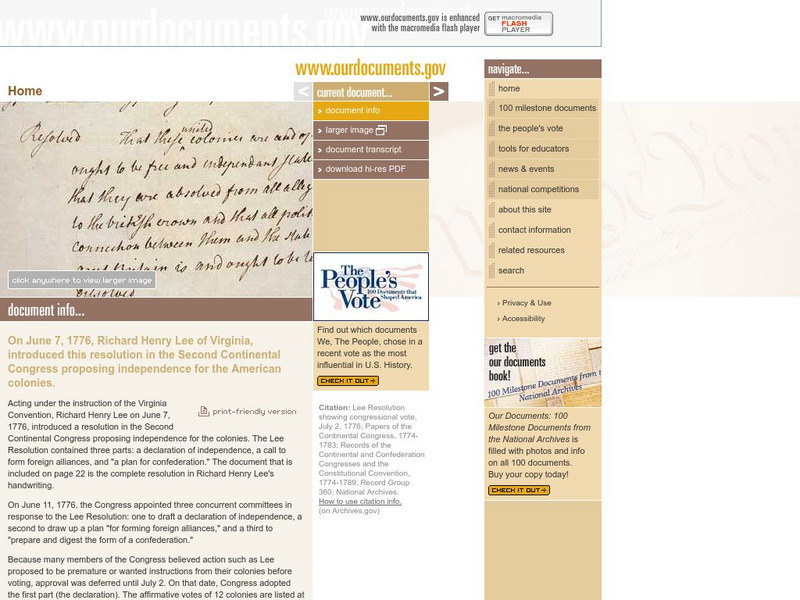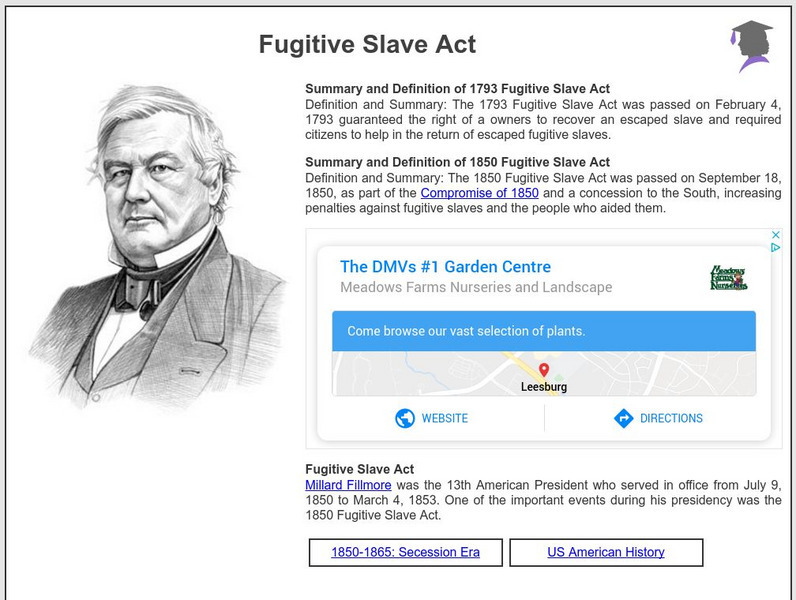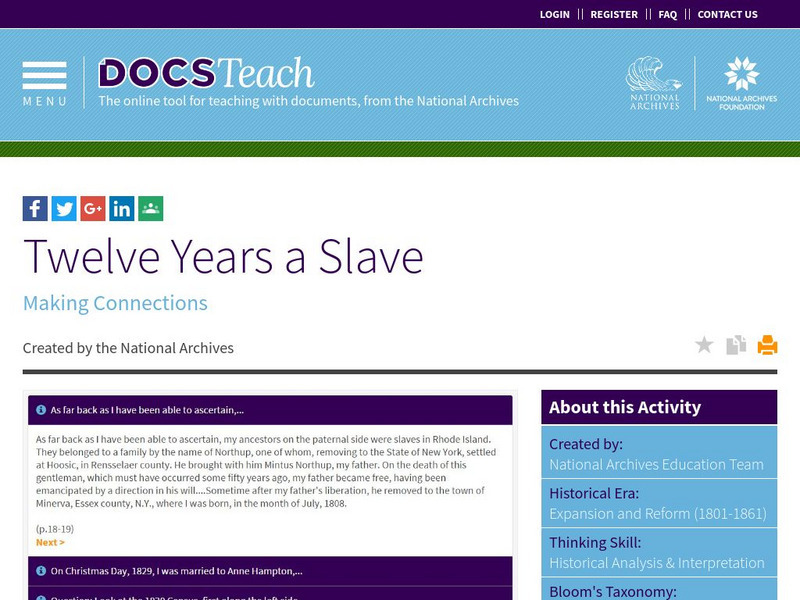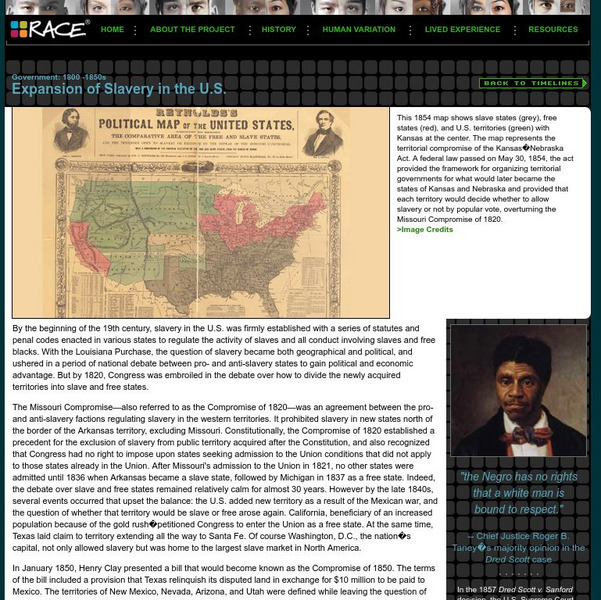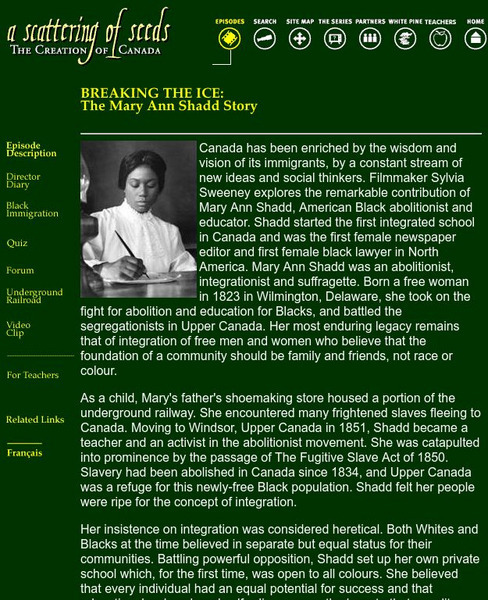Hi, what do you want to do?
Curated OER
History of the Americas: Causes of the Civil War
In this American Civil War worksheet, students respond to 36 short answer questions that require them to define people and events that were significant during the war.
Curated OER
Women Characters and Readers
Pupils participate in a guided reading of Chapter IX in Harriet Beecher Stow's, Uncle Tom's Cabin. They research the topic of gender and present it to the class.
Curated OER
Chapter 6 – Road to the Civil War
In this U.S. history instructional activity, students read assigned textbook pages detailing the causes of the Civil War and respond to 37 short answer questions.
Digital Public Library of America
Dpla: The Underground Railroad and the Fugitive Slave Act of 1850
This collection uses primary sources to explore the Underground Railroad and the Fugitive Slave Act of 1850. Set includes an overview, primary sources, links to related resources, and a teaching guide.
PBS
Pbs Learning Media: Primary Source: Underground Railroad Fugitive Slave Act 1850
This collection uses primary sources to explore the Underground Railroad and the Fugitive Slave Act of 1850.
University of Groningen
American History: Documents: Excerpts From "The Fugitive Slave Act"
This site titled, "From Revolution to Reconstruction," provides excerpts from the text of the Fugitive Slave Act of 1850, part of the Compromise of 1850.
OpenStax
Open Stax: The Compromise of 1850
From a chapter on " Troubled Times: the Tumultuous 1850s," this section explains the contested issues that led to the Compromise of 1850 and describes and analyzes the reactions to the 1850 Fugitive Slave Act.
US National Archives
Our Documents: The Compromise of 1850
The Compromise of 1850 attempted to settle sectional disagreements about slavery in the volatile pre-Civil War period. The compromise, actually a series of bills, had an enormous impact on the nation's slow march to civil war. See...
Siteseen
Siteseen: American Historama: Fugitive Slave Act
Discover interesting facts about the 1793 and 1850 Fugitive Slave Acts that guaranteed the right of an owner to recover an escaped slave.
PBS
Africans in America: Slave Narratives and Uncle Tom's Cabin
Slave narratives were an effective tool to spread information about what slavery was really like. Perhaps the most widely read literature about slavery happened to be written by a white woman, Harriet Beecher Stowe. Read about the impact...
PBS
Pbs Learning Media: Harriet Beecher Stowe: Author and Abolitionist
Through two primary source activities and a short biographical video, students will examine the content and impact of Stowe's Uncle Tom's Cabin.
Teachers.net
Teachers.net Lesson Plans: Slavery
This lesson offers a way to teach about the Underground Railroad by using maps and discussion about the problems fugitive slaves would encounter while trying to escape.
National Humanities Center
National Humanities Center: Toolbox Library: America in 1850: Henry Clay: Review of the Debate on the Compromise Bills
Henry Clay's speech in the Senate in support of the Compromise of 1850 and the importance of preserving the Union.
The History Cat
The History Cat: Countdown to Civil War
Describes the events leading up to the start of the American Civil War. Looks at clashes between pro- and anti-slavery groups, the Missouri Compromise of 1820, the fight over California, the Compromise of 1850, the Fugitive Slave Act,...
Other
Mission Us: Mission 2: Flight to Freedom
[Free Registration/Login Required] Players take on the role of Lucy, a 14-year-old slave in Kentucky. As they navigate her escape and journey to Ohio, they discover that life in the "free" North is dangerous and difficult. In 1850, the...
Curated OER
National Park Service: Operating the Underground Railroad
Read about the necessity for a loose organization such as the Underground Railroad. Click on "List of Sites" to find out about Underground Railroad stations across the north.
US National Archives
National Archives: Twelve Years a Slave
Solomon Northup was a free man of color who was sold into slavery. Students will read excerpts from his autobiography and analyze documents based on his life. These documents included slave manifests and census documents.
Other
American Anthropological Association: 1800 1850s: Expansion of Slavery in the Us
Outlines the political events prior to the Civil War as the United States expanded its territories to include new states and conflicts arose over the issue of slavery.
University of Maryland
Morality in Manufacturing: The Case of Bowen and Mc Namee [Pdf]
Using primary source documents as evidence, learners will create an annotated illustration depicting the situation among textile merchants in New York City while deciding in what ways do personal values influence business decisions.
ClassFlow
Class Flow: The Debate Over Slavery
[Free Registration/Login Required] This flipchart contains information about the renewed debate over the spread of slavery after the Mexican War. It describes the Wilmot Proviso, popular sovereignty, the Compromise of 1850, the Fugitive...
White Pine Pictures
White Pine Pictures: Breaking the Ice: The Mary Ann Shadd Story
Mary Ann Shadd was born in Wilmington, Delaware in 1823. She emigrated to Windsor, Upper Canada and was a leader in advocating for integrated schools at a time when most Canadians believed segregated schools should predominate. This web...
Digital History
Digital History: Civil War in Kansas [Pdf]
The Compromise of 1850 did not solve all the slavery issues in the territories, which was not surprising. Read about the Kansas-Nebraska Act, put forth by Sen. Stephan Douglas, who proposed that the issue be decided by popular...
Other
Freedom on the Move: Traveling Back
In this lesson, students will read and analyze ads written from 1850 to 1860 and make a timeline of the ads. They will consider important historical events, people, and literature from those years and build a timeline in their classroom...
Digital History
Digital History: The Impending Crisis: Conclusion
A concise review of the ways the issue of slavery split the country from the Missouri Compromise to eventual secession of the southern states.











